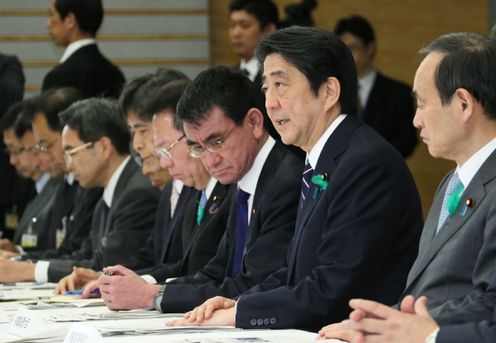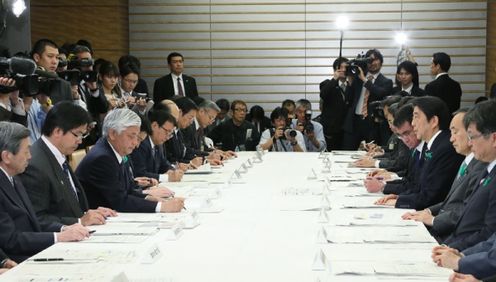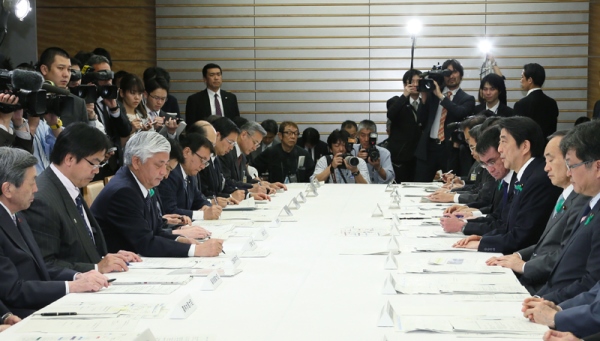Home > News > The Prime Minister in Action > April 2016 > Tenth Meeting of the Emergency Response Headquarters for the Earthquake Centered in the Kumamoto Region of Kumamoto Prefecture 2016
The Prime Minister in Action
Tenth Meeting of the Emergency Response Headquarters for the Earthquake Centered in the Kumamoto Region of Kumamoto Prefecture 2016
April 19, 2016

Photograph of the Prime Minister delivering a speech (1)

Photograph of the Prime Minister delivering a speech (2)
[Provisional Translation]
Prime Minister Shinzo Abe held the tenth meeting of the Emergency Response Headquarters for the Earthquake Centered in the Kumamoto Region of Kumamoto Prefecture 2016 at the Prime Minister’s Office.
At the meeting, reports and discussions were held on the situation pertaining to damage and the response of each ministry and agency.
The Prime Minister said in his opening address,
“Yesterday and today, among the individuals that we had been unable to contact, three bodies were found. I would like to express my heartfelt condolences.
The search operations are difficult, involving the removal of large amounts of earth resulting from landslides. However, I would like to request the Self-Defense Forces (SDF), police, fire departments, Japan Coast Guard, and others involved to continue to exert all possible efforts for rescue and relief activities, keeping their minds on the hopes for rescue on the part of the families of those still missing.
In regard to support for the people affected by the disaster, everyone on-site is working hard around the clock. Today, in harsh transportation conditions, distributors selflessly transporting supplies by land are cooperating with the SDF and the police to provide water and food which is vital for those affected by the disaster.
Progress has been made in restoring power, and electricity supply vehicles gathered from all over Japan have been distributed to some of the areas which had been without power. At Kumamoto Airport, this morning some passenger flights have begun again, while the railway lines between Hakata and Kumamoto have been repaired.
However, these measures are still by no means sufficient, and we must accelerate the various assistance measures, continuing to maintain a viewpoint of “what can we do for those affected by the disaster?”
Support staff from local governments throughout Japan are steadily coming to the affected areas in order to support the municipalities affected by the disaster that are working hard on the front lines. In addition to the three municipalities discussed yesterday, the government will also inject further staff, in particular to local governments which lack necessary personnel, within the coming days. I would like us to work as one with the local governments affected by the disaster and for the response measures to be carried out to be based on listening closely to the opinions of the affected individuals.
More than four full days have now passed since the occurrence of the first earthquake, and we must also give consideration to both the mental and the physical care of those affected. In particular, there is an urgent need to prevent the so-called ‘economy-class syndrome.’
As an emergency response that can be carried out immediately, in addition to the patrols and consultations being provided by local healthcare workers and others, we have begun the distribution of pamphlets on methods of preventing economy-class syndrome for those sleeping in cars, such as to consciously drink liquids before going to sleep. Furthermore, fifty doctors and nurses from throughout Japan have also gone to the affected areas, and I would like the information to be disseminated to those affected by the disaster, by this evening.
In order to fundamentally resolve issues caused by the restrictions of having to live in places such as evacuation shelters, starting with economy-class syndrome, we must rapidly create living environments. Already more than 1,500 accommodation facilities, 2,000 public housing units, as well as about 1,500 privately-rented homes, have been secured for people to move to from the evacuation shelters. In conjunction with the affected municipalities, and appropriately allotting the various initiatives, I would like you to urgently advance measures so that particularly those who require special attention and cannot return to their own homes, such as the elderly and those suffering from chronic illnesses, can move into these facilities as quickly as possible.
Moreover, waste is accumulating in the vicinity of the evacuation shelters, and there is concern about its possible negative effects on hygiene and health. Therefore, we have increased the temporary waste storage areas to 40 sites, and as the first effort from the nationwide support units, it is expected that six waste collection trucks from Kobe City will reach the affected areas, starting with Mashiki Town.
Conditions of those affected by the disaster change from moment to moment. While constantly, proactively thinking, “what do those affected by the disaster need right now?” please continue to exert your best efforts, working together with the affected municipalities, to speedily implement measures that meet the specific needs of the affected people, in a flexible manner.”


